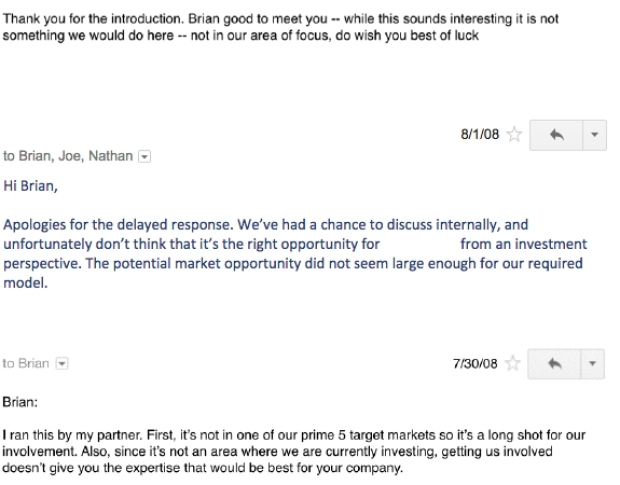The Information Memorandum Investors Actually Want To Read
You’re reading part 2/5 in the Buzinga crash course: How To Raise Startup Funds By Giving Investors What They Really Want
Go to part 1: The Essential Guide To Pitching Your App To Investors
Go to part 3: The Essential Financial Planning Template For App Startups
Go to part 4: The Secret To Acquiring Venture Capital Investment
Go to part 5: 7 Knockout Pitches Every Startup Needs To Watch
You never walk into an investment meeting empty handed!
An information memorandum (IM) is the document you hand to investors after you’ve delivered a hard-hitting pitch, just before you leave the room.
“Thanks so much for your time, Anne. I’ll just leave you with some material summarising everything I’ve mentioned today, and I’ll follow up with you in the next few days to answer any questions you may have”.
In Australia, if you are a private company (ie a ‘proprietary limited’ company with no more than 50 non-employee shareholders) you are required to produce some form of disclosure document when raising funds of a non-personal nature (ie: not your friends and family) in return for company equity.
The standard disclosure document is called a prospectus, and contains the broadest information requirements.
The prospectus and IM are very similar documents. Most of the information you are legally required to include in the prospectus will be included in your IM, but have a lawyer look over your IM to ensure you have included all the necessary information.
See also: ASIC regulatory guide for prospectuses
What is it?
An IM is your business plan in a nutshell.
It’s a short document, about 20-30 pages, which highlights the most important aspects and opportunities your investment offers.
It’s very similar to your pitch deck, which you would have used as a visual cue to support your pitch.
The main difference is your IM will be much meatier. It will include more analysis, projections and explanation than you could possibly reveal in your pitch without boring your investors to tears.
That’s not to say this document should be long and drawn out.
When creating your IM, think about how an investor is going to read it.
Do you think they’re going to sit down with a glass of wine and read it cover to cover? No way!
They’ll use it when a question pops into their head, when they need their memory jogged about something you touched on in your pitch, or when they need to quote a number.
They should be able to scan the contents page and flit immediately to the section, sub-section, even sub-paragraph, that contains the answer to their question.
Being succinct is key to a professional IM. You want punchy sentences. Fact after fact after fact!
Here are the sections you need to include, in order:
-
Letter from the director
-
Investment highlights
-
Executive summary
-
Company history with milestones achieved (including R&D)
-
Expansion plan
-
Market overview
-
Key success factors/metrics
-
Risks
-
The team (management team)
-
Financial information
-
Finance required/the offer
-
Ambitions (long term goals)
-
Any further information
These headings and structure are based on Integral Capital Group and Jack Delosa’s recommendations.
In this post I’m going to bundle up the best of the two and provide some further explanation and examples on how to write a professional information memorandum for your app startup.
Get set…GO!
1. Letter from the director
Source: Herald Sun
This short first page is your love letter to the investor.
Not really, but you need to woo them with your words!
This letter adds a personal touch to the IM by introducing what you and your business are about, your skills and experiences, and your vision for this idea.
We all know that even in business, people make quick judgements based on their first impressions.
Investors are only human after all, and they’re busy humans at that!
Just like the opening sentence of your pitch is hard hitting, grandiose and inspiring, your letter from the director should set up the rest of the IM for success.
- Who are you?
- What’s your big idea and where did it come from?
- What are your ambitions for this idea?
- Finish with something inspiring!
2. Investment Highlights
Source: Signature Analytics
This second page is arguably the most important of your entire IM.
This is often the first thing an investor will read in the IM (they might skip the letter if you stood out in your pitch), but unless you appeal and convince, it will be the last.
It should list in dot point form the key highlights of the investment, your offer, and what makes it such an exciting opportunity.
Why is your idea especially interesting or relevant to them?
Why should they keep reading?
3. Executive Summary
Source: GEhealth
This section is the most difficult to write in the entire document.
The executive summary serves as a short summary of the business plan. It was invented because executives didn’t have time to read a whole business proposal.
It should be written last and contain only the most relevant and significant points made in the IM.
I’ll tell you now that it will break your heart having to condense your entire product, business strategy and market analysis into 1-2 pages.
You might think the summary makes your business look superficial, but believe me, it’s worse to spew information that the investor has to wade through.
You’ll just look like an amateur who doesn’t know what the purpose of an executive summary is.
Allow plenty of time to write a succinct, appealing and convincing summary.
Use subheadings that correspond with the sections of your IM, so investors can easily refer to certain points. Dot points work well here too, as it’s just for scanning.
As a skeleton, make sure you include:
- The company and its founders – a very brief background highlighting your credentials (skills, qualifications and experience).
- The market opportunity – the size and growth prospects of the opportunity, projected market share
- The product/service/technology – unique features or functions
- Past track record – milestones achieved to date, a summary of sales, gross profits and pre-tax results explaining significant trends (if applicable)
- Summary of financial projections – sales profits over last 3 years (if applicable), briefly explaining trends
- The funding requirement – Re-state the capital you need, the share per investment and how the money will be used
4. Company History (with milestones achieved)
Source: Gizmodo
Your past might not seem so important, but looking at your track record is a common method investors use to evaluate your future potential.
Even if you’re a startup, there should be some key milestones you’ve achieved to get to where you are now, pitching to that investor.
What have you done to get here?
- Start with your date of formation/incorporation
- What phases of development have passed since then? Eg R&D, development, user testing, launch.
- The previous and current involvement of outside shareholders (you may want to include their names in an appendix)
- Any major agreements with investors, suppliers, clients or other credit sources
- Significant expansion of the team
- Indication of past financial performance (if applicable)
Just starting out in your venture? Here are some ideas:
- The size of your pre-launch database/email list
- Any clients you’ve got on board
- Any other investors you have on board
- Past successes, eg when you hit X number of downloads
- Credentials of your Advisory Board Members
These milestones almost act like social proof that your idea has traction, and shows you’re a founder who gets stuff done.
If there were setbacks in the company history, (you lost steam somewhere in the middle, ran out of funds, there was a massive drop in customer retention, etc) make sure you address these and talk about the steps you took to prevent these losses happening again.
Overall, this section needs to make you look productive!
5. Expansion Plan
Source: Lineshapespace
Your company history section will finish with where you are right now.
That’s a neat segue into talking about your product and where the business is going.
What are your goals, and what is your plan of attack to getting there?
This is all pretty high level stuff. Investors know that execution is always changing and there is some flexibility with your plan, so don’t worry if you don’t nail down exact dates.
At the minimum, you should cover key tasks for the next 3 years.
Be specific in describing which aspects of the business you see expanding, but always remain conservative. Keep assumptions at a minimum, and if you must make one, keep it conservative and explicitly state that it’s an assumption.
Here are some examples of high level tasks:
- Raise investment
- Launch version 2/major update
- Expand existing product line, add a new feature
- Market expansion – Serve a different customer segment or geographical segment
- Increase number of employees
- Open an additional office location
You should go into more detail that this, however.
Eg: Raise investment – how much and from who?
Expand existing product line – to what, and why is this a good idea?
Analyse data – what are you going to be looking for in the data?
You don’t need to go overboard, but looking ambitious and organised will show investors this business has long-term potential, and ‘de-risk’ their investment.
It’s also important to justify every step in your growth plan.
Why do you want to expand to serve Adelaide in 2 years time?
What evidence exists that this is a good opportunity and a good move for your business at that exact time?
This shows that you haven’t just thrown in growth milestones because they look good on paper. These milestones should be highly specific to your business.
6. Market Overview
Source: Drsharma
Know your market back to front!
This section shows you’ve done your homework – that you’re aware of a world of product offerings, competitors and customers that exist outside your business.
With regards to the market itself, you need to include:
- Size of the market
- The gap in the market – what problem does your app solve?
- What segment of the market you’re addressing
- Market growth – is it a mature/stagnating market or a growing one?
Use free resources like the Australian Bureau of Statistics, App Annie quarterly app store reports, Mintel and Passport Monitor to dig up some stats.
With regards to competitors, you need to include:
- An identification of your top 3 competitors
- A business comparison – What is their unique selling proposition? What is their monetisation strategy? What is their marketing strategy?
- Their target markets
- Their app store presence – their average rating, their good and bad reviews, their keywords
See also: How to rank #1 on the app store
The best way to find this information is by executing a SWOT analysis.
A SWOT analysis is a breakdown of your competitors’ perceived strengths and weaknesses, what opportunities they create for you and what threats are presented.
Strengths
- What advantages does their application have?
- What do they do well?
Weaknesses
- What could they improve?
- What should they avoid?
- What are people in the market likely to see as a weaknesses?
- What other weaknesses do they have?
Opportunities
- What opportunities can you spot that they should be taking advantage of?
- What interesting trends are you aware of that they may not have noticed?
Threats
- What obstacles do they face?
- What are they doing that could pose a threat to your business?
- Is changing technology threatening their position?
- Could any of their weaknesses seriously threaten their business?
See also: The Ultimate Guide To Performing A Competitive Analysis On Apps
Displaying this information on competitors will clearly illustrate how your app is different.
It doesn’t have to be different in every aspect. Your app might have the exact same functions as a competitor, but be more user friendly and marketed towards a different target user.
Whatever it is, you’ll need some convincing analysis to back up the claims you’ve just made, and prove that your idea has legs to stand on.
7. Key Success Factors/Metrics
Source: Ezyinsights
What do you need to get right in order to go from where you are now to where you want to be?
Key success factors demonstrate to investors that you’ve thought about ways in which they’ll be able to assess your performance.
It shows them specifically what outcomes they should look for as a result your efforts.
Key success factors are invaluable for founders as well as investors, because they serve as useful benchmarks to reaching your goals.
In terms of measuring your app’s success, there are 5 key metrics:
- Acquisition metrics – download and discovery
- Engagement metrics – Active users, average session length
- Retention metrics – customer lifetime value, churn rate
- Quality metrics – app store reviews and ratings, manual feedback, automatic crash reports
- Behaviour metrics – Devices, location, usage time and frequency, user actions
See also: How To Measure Your App’s Success
As well as measuring the success of the product itself, set some KPIs for your business aswell:
- Revenue/ROI
- Costs
- Awareness
- social media presence
- employee growth
8. Risks
What are the risks involved in investing in a business like this?
More importantly, how have you mitigated them?
Your IM will invariably contain some assumptions, so this is where you can address them.
It’s crucial that you consider any and every possible risk involved. If a potential investor identifies a significant risk that you hadn’t considered, it seriously undermines your credibility.
Here’s an actual quote from Blockbuster’s 1999 analyst report: “Investor concern over new technologies is overstated”.
And here’s a photo of a Blockbuster store now:
Source: Vala Afshar
Moral of the story? Every business venture contains risks.
You might be hesitant to reveal to investors the very real risks of their investment, but you shouldn’t be.
Discussing risks demonstrates that you’ve considered the investment proposal thoroughly, and that you’ve put yourself in the shoes of the investor.
What can these risks relate to?
- The industry
- The company and personnel
- Product development
- Market
- Timing and financing of the venture
Here are some examples of risks:
- Competitor moves in on your target market
- Overspending on design/development
- Time delays for launch
- Inability to recruit staff
- New industry regulation introduced
List risks in order of importance and likelihood of happening.
Beside each one, state the steps you’re taking to minimize the impact of these risks (should they actually occur).
Your risk section doesn’t need to be negative! Transform it into a positive by showing investors your are realistic and proactive.
9. The Management Team
Source: Martindawedesign
The people in and around a team are the number 1 an investor will look to when investing in an early-stage business.
Why is that?
Without much in the way of data, a customer base or a viable product, the team is the best indicator of a venture’s success.
State why your team is investment worthy. What skills, connections and experience does each person bring to the table?
Include a photo and a short bio of each person involved in this venture, not limited to immediate or full time staff.
Include any advisors and mentors you can leverage credibility off.
See also: How To Hire Rockstar Talent For Your Startup
10. Financial Information
Source: Knowlium
This section brings the whole IM together in the form of juicy numbers.
Here’s what you need to include:
- Details of any previous financial records, briefly explaining any significant trends
- Projected growth for the next 3-5 years – state targets for total customers, revenue and expenses for each year
- Any assumptions you’ve made in your projections
Click here for a customisable profit and loss forecasting spreadsheet for your app startup.
Investors fully expect to see these projections at the bare minumum.
It’s basic to the evaluation of an investment opportunity, as well as determining how much company equity the investor will want in return for their investment.
These projections should be justified by the strategies you’ve previously outlined in the IM, and should be conservative.
11. The Investment Offer/Finance Required
Source: Carinsurancecomparison
Round off the guts of the IM with the investment offer.
- How much are you valuing your company at?
- How much in total do you need to raise?
- How much capital are you looking for from this investor right now, and at what cost per share?
- What are you doing to raise that money? Include crowdfunding, government grants, other investors
- Where is that money going exactly? How will it be applied to reach your key success factors?
- How will investors realise this investment?
See also: The Secret To Acquiring Startup Investment In Australia
12. Ambitions/Long term goals
Source: Washington Post
It’s nice to finish your IM on a positive note.
Include a short paragraph of your big hairy audacious goals (BHAGs) that will inspire investors and bring them back to the same excitement level they had when you were pitching.
An IM is a very formal document, so including a personalised touch at the start and finish puts them in a great frame of mind to read your plan, and reflect on it later.
It also helps investors determine if they’re compatible with your business.
Unlike the milestones covered in your expansion plan, these goals are your overarching vision for the business. They shouldn’t be able to be achieved in less than 10 years.
Throw any doubts or restrictions out the window and think about what you want your app to achieve in the long term.
Do you want to expand to every continent?
Do you want to be acquired by Microsoft or Google?
Do you want to revolutionize an industry and completely eliminate the current market leader?
Whatever it is, bundle it up neatly and concisely in a little inspiring package.
Don’t worry about sounding stupid. If you’re not embarrassed or overwhelmed by your long term goals, they’re not big enough.
13. Further Information
Source: ffvs
This section is basically an appendix to your IM.
Investors might not even look at it, but it serves as a place for them to find further information that isn’t immediately relevant to the investment opportunity (eg legal statements, disclaimers, financial statements, raw data).
Your IM should be able to stand on its own, so it’s a good idea to throw in anything you think there is a slight chance investors will want to see.
One final note…
Don’t be scared of rejection. It happens to everyone!
Check out these rejection emails Brian Chesky received from Silicon Valley investors after he pitched AirBnb. Read the full list here.
Source: AFR
Every investment opportunity is different, just like every business and team is different.
If you follow this structure, you’ll have a professional document to hand to investors when leaving an investment meeting.
Good luck!
Need Startup Funds?
Get access to your customisable pitch deck and learn how to craft a knockout pitch that makes investors take notice!
Continue the crash course…
Go back to part 1: The Essential Guide To Pitching Your App To Investors
Go to part 3: The Essential Financial Planning Template For App Startups
Go to part 4: The Secret To Acquiring Venture Capital Investment
Go to part 5: 7 Knockout Pitches Every Startup Needs To Watch
Latest posts by Logan Merrick (see all)
- Ep 18: Collective Campus’ CEO on Intrapreneurship and Corporate Innovation - December 20, 2016
- 50 User Engagement Strategies For Planning Memorable Mobile Experiences - December 19, 2016
- Latest Data: App Monetisation Trends And Drivers 2015-2020 - November 25, 2016


















